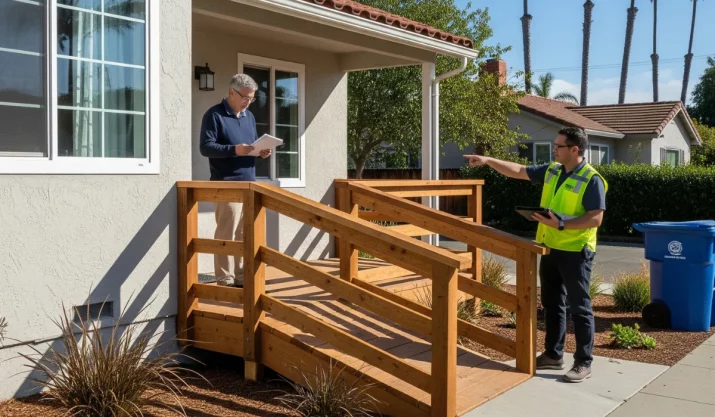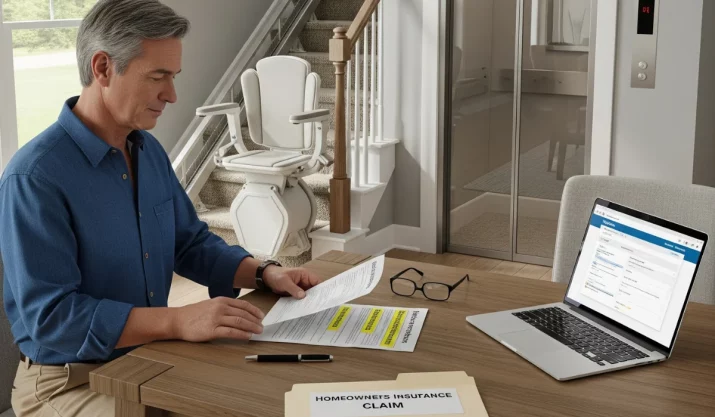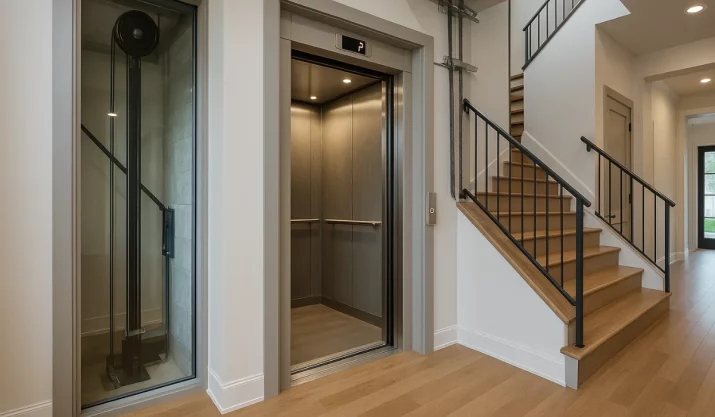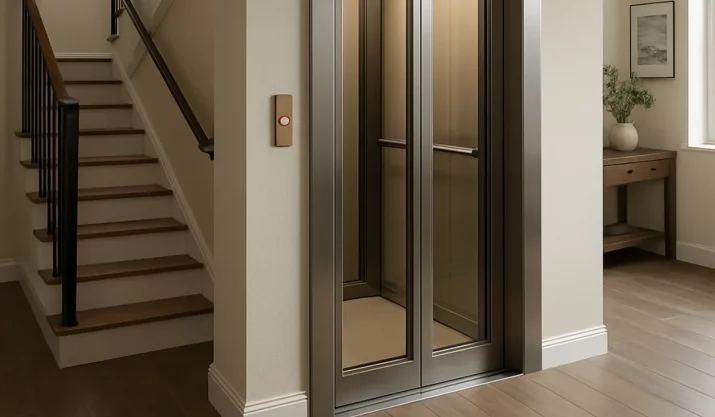Do I need a permit to add a wheelchair ramp in California?

Table of Contents
- Key takeaways
- When does a wheelchair ramp require a permit in California
- ADA compliance and California ramp requirements
- What inspectors look for in a ramp permit inspection
- Residential vs. commercial wheelchair ramp permits in California
- Making the right wheelchair ramp permit choice in California
- FAQs
Are you planning to add a wheelchair ramp to your California home or business? A ramp makes it easier for loved ones or customers with mobility needs to enter safely. Before building a ramp, confirm whether you need a permit. The rules change based on your city, property type, and ramp design.
California enforces strict accessibility and safety standards. Many local building departments in cities like Los Angeles, San Diego, and Sacramento require ramps to meet both state codes and ADA requirements. These rules cover everything from slope and handrail height to landing size, ensuring ramps are safe, durable, and truly accessible.
These strict requirements not only improve wheelchair access but also protect you from liability if an accident happens.
In this guide, we’ll explain when a wheelchair ramp permit is required, why ADA compliance matters, what inspectors check, and how residential and commercial rules differ so you can make the right choice for your California property.
Key takeaways
- A wheelchair ramp permit in California is usually required for permanent ramps, especially those with a rise of over six inches.
- ADA compliance ensures ramps meet national accessibility standards, including slope, width, and landings.
- Inspectors check details like handrails, cross slope, and edge protection before approving a ramp.
- Residential ramps may have simpler requirements, but commercial handicap ramps must meet strict ADA and California building code standards.
When does a wheelchair ramp require a permit in California
In California, you usually need a permit when you build or attach a wheelchair ramp to a structure. For example, if you add a ramp to the entrance of a San Jose home, the city’s building department will ask you to submit plans. This process ensures the ramp’s slope and handrails meet code.
If you run a business, you need a wheelchair ramp permit because the Americans with Disabilities Act (ADA) covers public spaces. Business owners must follow ADA standards for ramp width, intermediate landings, and handrail height. A local inspector will review the ramp you plan to build before giving final approval.
Some small residential ramps do not need permits. Portable ramps that don’t alter the property often don’t need a permit, but permanent ramps with a rise over six inches almost always do. To confirm, check your local .gov building department.
ADA compliance and California ramp requirements
Following ADA rules does more than help you avoid fines. Complying with ADA standards ensures your ramp is safe and usable for people with mobility impairments. The ADA sets national standards. However, California often enforces them with additional state-specific rules.
The ADA limits ramp slope to 1:12, meaning for every inch of rise, the ramp must run at least 12 inches. The ramp must also include level landings at the top and bottom to ensure the safety of users. Longer ramps require intermediate landings every 30 feet. These ramp landings must be wide and level enough for wheelchair users to turn safely.
The California building code also requires edge protection on ramps to prevent roll-off and slip-resistant ramp surfaces. Your ramp will also need to have proper ground surface transitions to adjacent walkways or parking spaces for a smooth transition. For outdoor ramps, inspectors may look for detectable warnings at curb ramps to help visually impaired individuals navigate safely.
What inspectors look for in a ramp permit inspection
When you apply for a wheelchair ramp permit in California, expect the inspector to check several details before approval:
First, they’ll measure the ramp width to ensure it meets the minimum ADA ramp guidelines. They’ll also confirm the cross slope does not exceed 1:48, since too much tilt makes an accessible route unsafe.
Next, they’ll check the ramp handrails. California code requires continuous handrails on both sides for ramps with a maximum rise of six inches. These must have a proper gripping surface, consistent handrail height, and, in some cases, guardrails for added safety on higher ramps.
Finally, inspectors check the landing area. Each top landing and drop-off zone must be stable and large enough for turning. If the landing is too narrow or uneven, the ramp fails inspection. If a ramp connects directly to a stairway, inspectors pay extra attention to ensure it remains safe and accessible.
Residential vs. commercial wheelchair ramp permits in California
Getting a permit for a wheelchair ramp in California depends on whether it’s for a home or a business.
For homeowners, the main goal is safety. Most cities, such as Fresno or Oakland, usually ask for basic drawings and proof of ADA compliance. After you build the ramp, an inspector checks the slope and surfaces for safety before giving final approval.
For businesses, the rules are stricter. Since public entrances must be fully accessible, ramps need extra features like guardrails, warning strips for the visually impaired, and flat landings for turning. If businesses don’t meet these standards, they can face legal issues under federal law.
Because the requirements are more demanding, many commercial projects bring in architects or contractors who are familiar with ADA regulations to design their access ramp. That way, the ramp meets both state and federal codes the first time.
Making the right wheelchair ramp permit choice in California
Installing a wheelchair ramp is a meaningful upgrade that improves both safety and convenience. The process can seem complicated with city rules, permits, and inspections, but it does not have to be stressful.
California Mobility is here to help. Our team manages every step of the project, from permit paperwork to final installation, so you can focus on enjoying safe and reliable access.
Whether you are preparing your home for a loved one or updating your business for customers, we make sure your new ADA-compliant ramp is built quickly, safely, and in full compliance with the law.
Contact us today to start your wheelchair ramp project with confidence.
FAQs
Do I always need a permit to install a wheelchair ramp in California?
In most cases, yes. Permanent ramps that change your home or business need a permit. Portable ramps often don’t need a permit, but always confirm with your local building department.
What are the ADA requirements for a wheelchair ramp?
The ADA requirements include a maximum slope of 1:12, level landings at the top and bottom, continuous handrails, and proper clear width for safe passage. California often adds extra rules for edge protection and detectable warnings.
How long does it take to get a wheelchair ramp permit in California?
Processing time depends on the city. Some departments issue permits in a week, while larger cities like Los Angeles may take longer. Submitting clear, ADA-compliant plans speeds approval.








